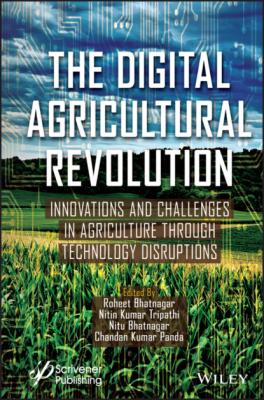ТОП просматриваемых книг сайта:
The Digital Agricultural Revolution. Группа авторов
Читать онлайн.Название The Digital Agricultural Revolution
Год выпуска 0
isbn 9781119823445
Автор произведения Группа авторов
Жанр Программы
Издательство John Wiley & Sons Limited
To offer correct information to farmers, the system incorporates remote sensing data from the Indian Space Research Organization (ISRO), data from soil health cards, weather predictions from the India Meteorological Department (IMD), and soil moisture and temperature analysis, among other things [35]. Similarly, a growing number of Indian start-ups are using AI-based agricultural solutions. A start-up has used data science, AI, and ML algorithms, as well as data sets from ISRO, to estimate crop damage and give compensation based on the amount of damage.
Even though the green revolution system in India made the nation self-sufficient in food grains, the agricultural sector should use modern technologies like AI, ML, and robotics. Many start-ups help in finding ways so that farmer receives various inputs and suggestions via mobile phones. CropIn is a company in Bengaluru that helps the farmers to know the quality of soil, assists the farmers to monitor the crops, and alerts them when the disease impends on the crops through a specific alert system. Deep Learning algorithm-based Graphical User Interface system has been developed by Intello labs situated in Bengaluru. It helps farmers to know crop health through image processing techniques. Microsoft India came out with a new AI-based App, which helps the farmer to sow the seeds at right time with the big data techniques by collecting climatic data over the past 30 years from 1986 to 2015.
Increased public and private investments, particularly from venture capitalists, are required to enable these AI technologies
1.9 Case Study in Plant Disease Identification Using AI Technology—Tomato and Potato Crops
The traditional method of plant disease identification through visual observations of the symptoms of plant leaves leads to a significant high degree of inaccuracy. Today modern tools incorporate graphical processing unit which includes ML-based algorithms which precisely detect the plant disease and assist the pathologist to easily identify the disease. Machine learning is the subset of AI that uses algorithms that predicts experience. Nowadays, a technology named DL using a large amount of processing layers made exponential growth in AI. The common diseases of tomato and potato crops are blackleg, early blight, late blight, stem rot, and ring rot. Figure 1.9 and Figure 1.10 show the late blight and leaf spot of tomato crop and the early blight and stem rot of potato crop, respectively.
Figure 1.9 Late blight and leaf spot of tomato crop.
Figure 1.10 Early blight and stem rot of potato crop.
Apps are given for farmers to know the current status of the crop and get an opinion from the experts [25].
1.10 Challenges in AI
Practicing AI is difficult for the agriculture field. Even for a small field, the condition keeps changing from one area to another. Also, unpredicted weather conditions change soil quality. The presence of pests and diseases often visits the field [3]. Because no two environments are alike, it is difficult to deploy ML and DL-based AI models in the agricultural field although scientists are capable of developing programs for large sectors [35]. Moreover, the testing and validation of such models require more laborious than in other fields. As per Indian agriculture is concerned, the road is not smooth and it is up to the farmers, businessmen, and consumers to use the power of AI to increase production.
While IoT-enabled gadgets and sensors are not prohibitively expensive, buying in quantity can be costly. A proper local network must be set up in addition to the hardware to permit and handle a large amount of data and there comes the issue of data storage, which might be local or cloud-based.
To function, all new technologies necessitate the use of energy. Massive amounts of energy will be required to support a large-scale agricultural activity. Furthermore, many modern robots and solutions continue to operate on fossil fuels, damaging the environment. IoT and other current technologies are not a proper cure for environmental challenges without more sustainable energy or even renewable alternatives.
1.11 Conclusion
Artificial Intelligence helps farmers to increase the crop yield and quality of production. Many start-ups are growing to automate farming using modern technology. The main challenges in deploying AI and ML are unpredictable weather, frequent change in soil quality, the possibility of uncontrollable pests, and so on. It is imperative that any application of AI needs to be carefully designed and implemented which benefits the end-users. The use of AI in agriculture in India might promote mechanization. By implementing precision agriculture, it would boost productivity.
References
1. Pathan, M., Patel, N., Yagnik, H., Shah, M., Artificial cognition for applications in smart agriculture: A comprehensive review. Artif. Intell. Agric., 4, 81–95, 2020.
2. Agriculture in India: Information About Indian Agriculture & Its Importance, IBEF, Last updated on Dec. 30, 2020, https://www.ibef.org/industry/agriculture-india.aspx.
3. Bhar, L.M., Ramasubramanian, V., Arora, A., Marwaha, S., Parsad, R., Era of Artificial Intelligence: Prospects for Indian Agriculture, Indian Farming, 69, 3, 2019.
4. Ferentinos, K.P., Deep learning models for plant disease detection and diagnosis. Comput. Electron. Agric., 145, 311–318, 2018.
5. Artificial Intelligence in Indian Agriculture, 20 February 2020, https://www.ciiblog.in/technology/artificial-intelligence-in-indian-agriculture/#:~-:text=In%20Andhra%20Pradesh%2C%20India%2C%20with,per%20hectare%20has%20been%20seen.
6. Amarendra, ICRISAT develop app and dashboard to help farmers find right time to sow crops, August 25, 2016.
7. Anonymous: Soil health monitoring in India, 2017, https://www.icfa.org.in/assets/doc/reports/Soil_Health_Management_in_India.pdf.
8. Sahoo, K.M. and Saraswat, V.N., Magnitude of losses in the yields of major crops due to weed competition in India. Pestic. Inf., 14, 1, 2–9, 1988.
9. Bhan, V.M., Sushilkumar, Raghuwanshi, M.S., Weed management in India. Indian J. Plant Prot., 17, 171–202, 1999.
10. Varshney, J.G. and PrasadBabu, M.B.B., Future scenario of weed management in India. Indian J. Weed Sci., 40, 1&2, 01–09, 2008.
11. Gharde, Y., Singh, P.K., Dubey, R.P., Gupta, P.K., Assessment of yield and

